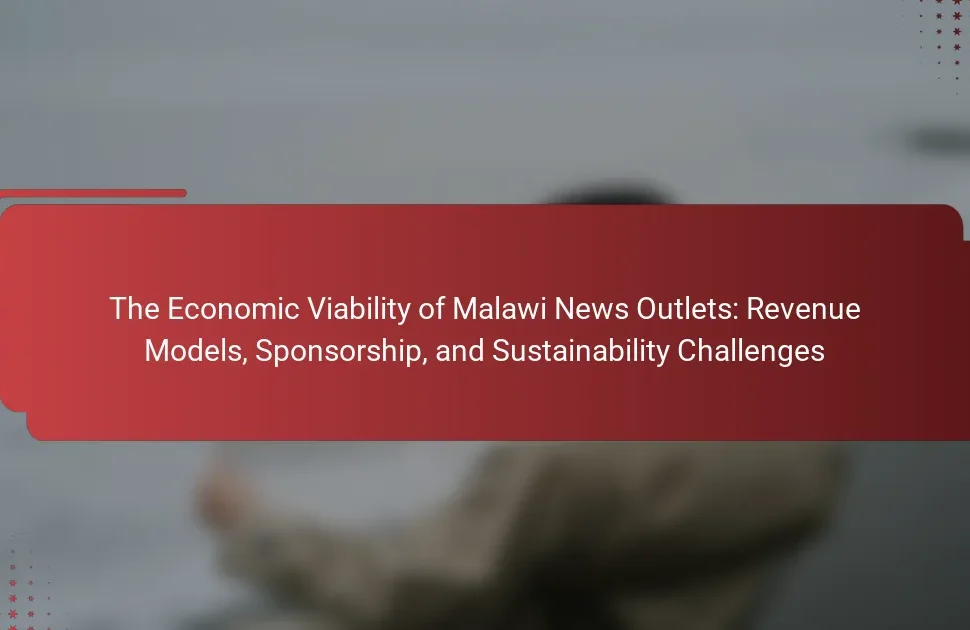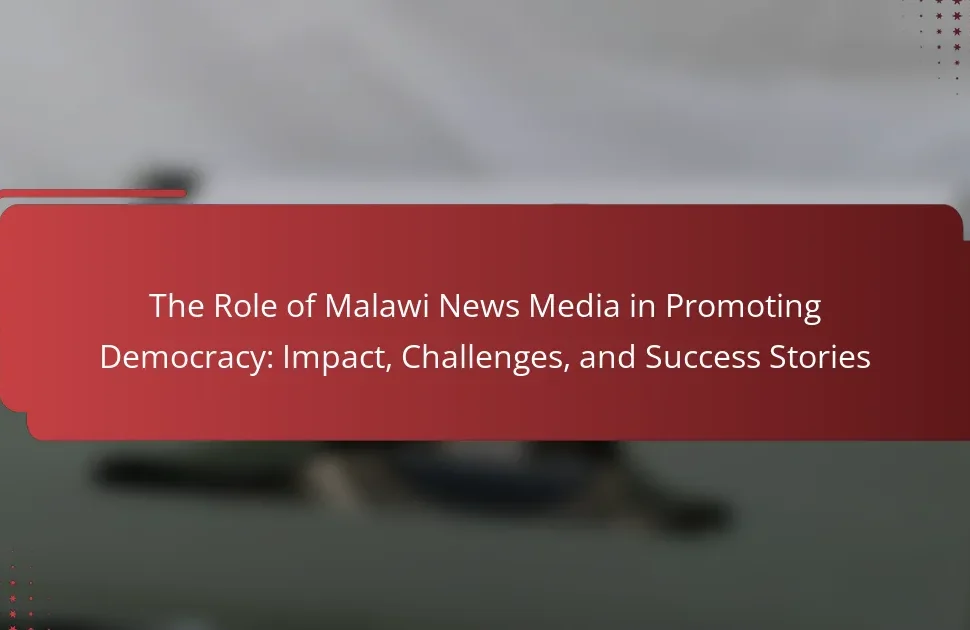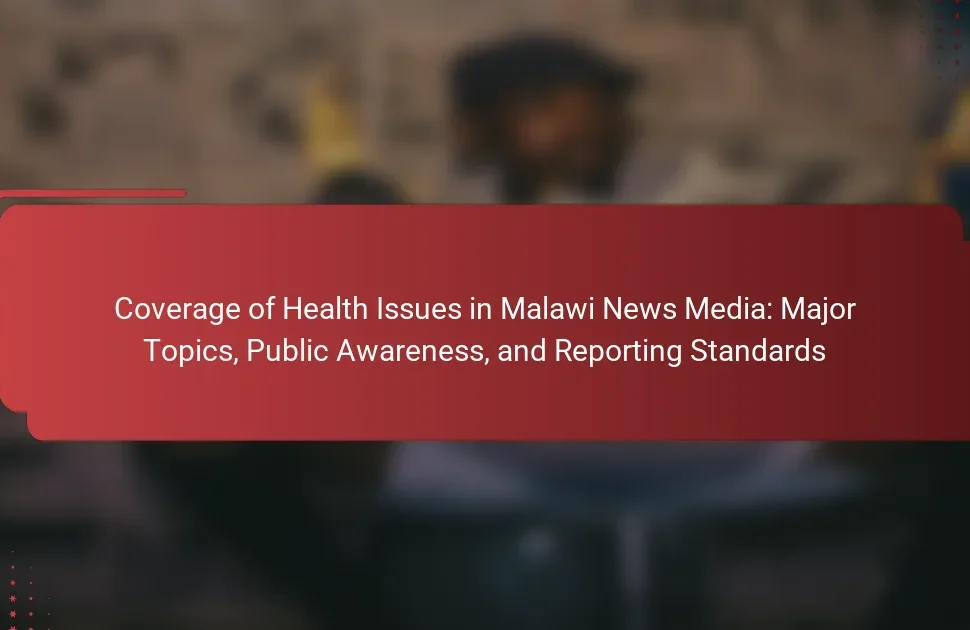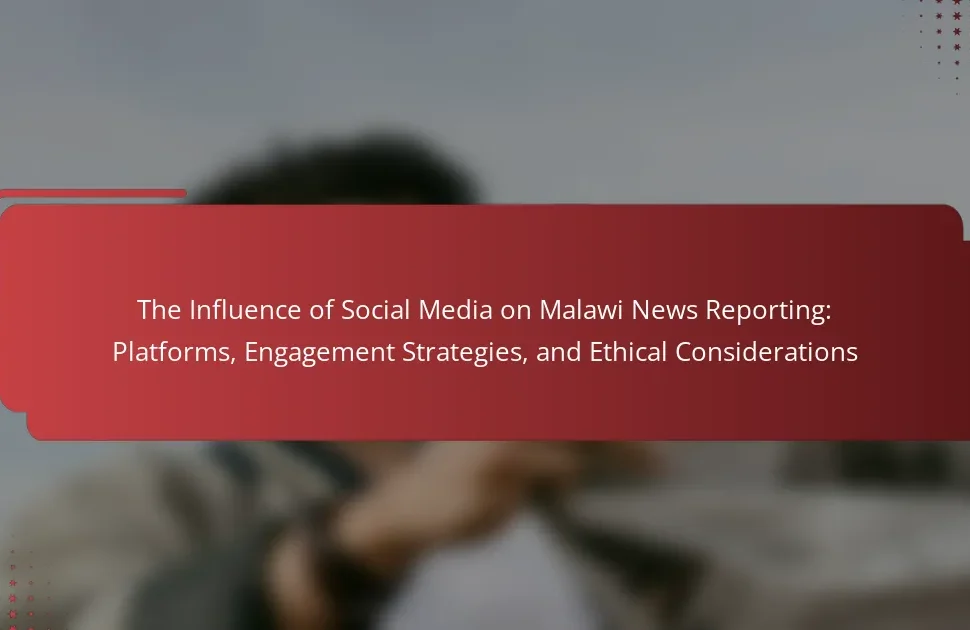Malawi news media has undergone significant transformations influenced by historical, technological, and socio-political factors. The evolution began during the colonial era with limited press freedom, followed by stringent controls post-independence in 1964, leading to censorship. The democratic transition in the 1990s marked a shift towards a more diverse media landscape, with the rise of private outlets and digital platforms in the 2000s. Currently, mobile technology and social media play crucial roles in news dissemination, enhancing access and engagement among the population. Future trends indicate an increasing reliance on digital and mobile news consumption, along with a focus on multimedia content and citizen journalism, reflecting a broader global movement towards more accessible news sources.
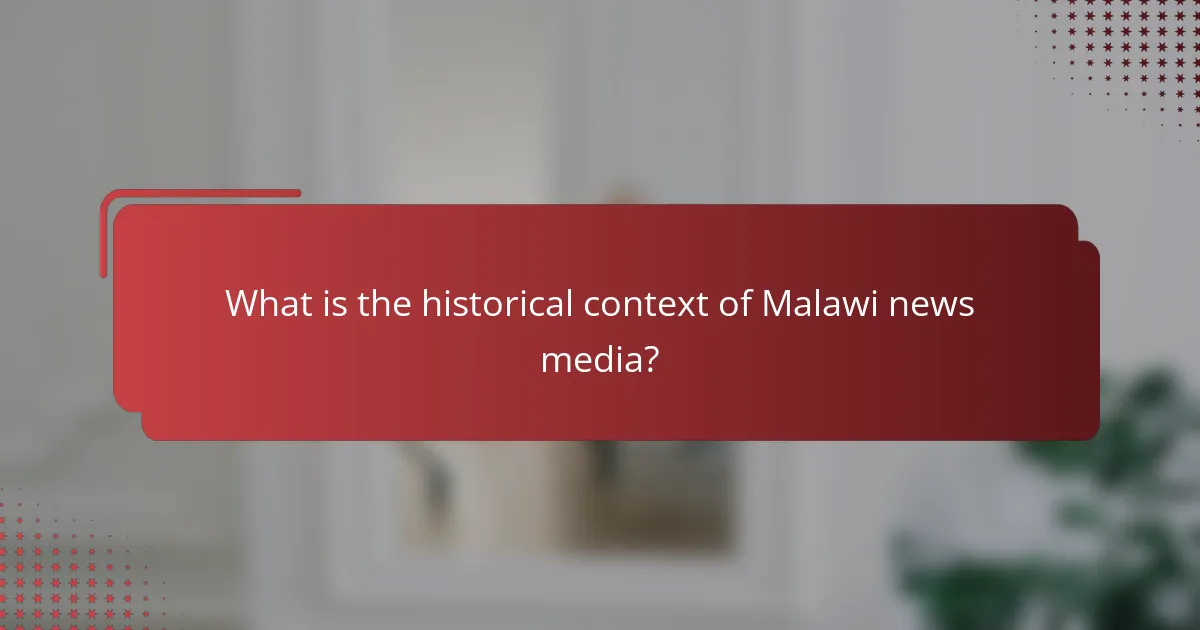
What is the historical context of Malawi news media?
Malawi news media has evolved through significant historical phases. The colonial period saw limited press freedom, primarily serving British interests. After independence in 1964, the government imposed strict controls over media, leading to censorship and repression. In the 1990s, a democratic transition began, fostering a more vibrant media landscape. This period saw the emergence of private newspapers and radio stations. The 2000s introduced digital media, enhancing access to information. Current challenges include political influence and economic constraints on media operations. Overall, Malawi’s news media reflects its socio-political changes throughout history.
How has the history of Malawi influenced its news media landscape?
Malawi’s history has significantly shaped its news media landscape. The colonial era established a foundation for media that was largely controlled by the British. After independence in 1964, Malawi experienced a period of strict media censorship under President Hastings Banda. This repression stifled journalistic freedom and limited public discourse. The transition to multiparty democracy in the 1990s led to a diversification of media outlets. This era saw the emergence of private newspapers and radio stations, enhancing access to information. The 1998 Malawi Communications Act further liberalized the media environment, promoting freedom of expression. Today, Malawi’s media landscape reflects its historical struggles for independence and democratic governance, balancing state influence with a vibrant civil society.
What key historical events have shaped Malawi’s media development?
Malawi’s media development has been significantly shaped by several key historical events. The introduction of colonial rule in the late 19th century established early forms of media. The first newspaper, the “Nyasaland Times,” was launched in 1906, marking the beginning of print journalism.
The independence of Malawi in 1964 led to the establishment of a state-controlled media environment. Under President Hastings Banda, media was heavily censored to suppress dissent. The 1994 democratic transition allowed for the emergence of private media outlets.
This shift resulted in a diversification of voices and perspectives in the media landscape. The establishment of the Malawi Communications Regulatory Authority in 2000 further regulated the media sector.
In recent years, the rise of digital media has transformed how information is disseminated. Social media platforms have become crucial for public discourse and activism. Overall, these events have collectively influenced the trajectory of media development in Malawi.
How did colonialism impact the evolution of news media in Malawi?
Colonialism significantly shaped the evolution of news media in Malawi. During the colonial period, British authorities controlled information dissemination. They established newspapers that primarily served colonial interests. These newspapers often marginalized local voices and perspectives. The first newspaper, the “Nyasaland Times,” launched in 1895, reflected colonial viewpoints. Colonial rule also introduced Western journalism standards and practices. This led to a dual media landscape, where local languages and content were often excluded. Post-colonial, Malawi’s media landscape began to diversify, reflecting a broader range of voices and issues. The legacy of colonialism remains evident in contemporary media dynamics.
What role did independence play in the transformation of Malawi news media?
Independence played a crucial role in transforming Malawi’s news media landscape. After gaining independence in 1964, Malawi experienced a shift from colonial control to greater local ownership of media. This transition allowed for the emergence of independent newspapers and radio stations. The government initially maintained strict control over media content. However, the late 1990s saw increased liberalization and the rise of diverse voices in journalism. The introduction of new technologies further facilitated this transformation. By the early 2000s, Malawi’s media landscape became more vibrant and pluralistic. This evolution reflects the broader societal changes following independence, promoting democratic discourse and citizen engagement.
How did the political climate post-independence affect media freedom?
The political climate post-independence significantly restricted media freedom in Malawi. Following independence in 1964, the government imposed strict censorship laws. These laws limited the press’s ability to criticize the government. Journalists faced persecution for reporting on sensitive issues. The state controlled most media outlets, stifling independent voices. This environment led to self-censorship among journalists. The oppressive political atmosphere hindered the development of a free press. Consequently, media freedom remained limited for decades.
What significant media reforms occurred in the years following independence?
Significant media reforms in Malawi following independence included the establishment of a more pluralistic media environment. In 1993, the government abolished the state monopoly on broadcasting. This led to the emergence of private radio and television stations. The 1995 Communications Act facilitated the licensing of private broadcasters. Additionally, the Media Council of Malawi was formed to promote ethical journalism. These reforms aimed to enhance freedom of expression and access to information. The transition to a democratic system played a crucial role in these changes. These actions marked a shift towards a more open and diverse media landscape in Malawi.

What technological advances have impacted Malawi news media?
Mobile technology has significantly impacted Malawi news media. The widespread use of mobile phones allows for real-time news dissemination. Many Malawians access news through SMS and mobile applications. Internet [censured] has also increased, enabling online news platforms. Social media platforms like Facebook and Twitter facilitate news sharing and engagement. Digital literacy programs have enhanced the public’s ability to consume and interact with news. These technological advances have transformed how news is produced and consumed in Malawi.
How has the rise of the internet changed news consumption in Malawi?
The rise of the internet has significantly transformed news consumption in Malawi. Access to online news platforms has increased rapidly. Many Malawians now rely on social media for news updates. This shift has reduced the dominance of traditional media outlets. Internet [censured] in Malawi reached approximately 20% by 2021. This growth has facilitated real-time news access. Moreover, online platforms allow for diverse viewpoints and citizen journalism. Consequently, the public can engage more actively in discussions.
What are the most popular online platforms for news in Malawi?
The most popular online platforms for news in Malawi include Malawi24, Nyasa Times, and The Nation. Malawi24 is known for its real-time news updates and diverse coverage. Nyasa Times offers in-depth analysis of political and social issues. The Nation is recognized for its comprehensive reporting and investigative journalism. These platforms are widely used for accessing news in Malawi, reflecting the country’s growing digital media landscape.
How do mobile devices influence news access in rural areas?
Mobile devices significantly enhance news access in rural areas. They provide a platform for instant communication and information dissemination. In Malawi, mobile phone [censured] reached 47% in 2021, facilitating access to news. Rural residents can receive updates via SMS and social media. This access helps bridge the information gap between urban and rural populations. Mobile devices also enable local news outlets to reach wider audiences. Furthermore, they allow for real-time reporting during events like elections or emergencies. Overall, mobile devices are crucial in improving news accessibility in rural regions.
What innovations in broadcasting have emerged in Malawi?
Recent innovations in broadcasting in Malawi include the introduction of digital broadcasting technologies. The transition from analog to digital has improved audio and video quality. Additionally, the use of mobile broadcasting platforms has expanded access to news. Community radio stations are utilizing social media for real-time updates. The government has also encouraged public-private partnerships in broadcasting. These initiatives aim to enhance content diversity and reach. Furthermore, the rise of online streaming services is changing how audiences consume media. These advancements reflect a broader trend towards modernization in Malawi’s media landscape.
How has community radio evolved to serve local populations?
Community radio has evolved to serve local populations by focusing on their specific needs and interests. Initially, community radio aimed to provide a platform for marginalized voices. Over time, it has incorporated local languages and cultural content to enhance accessibility. Technological advancements have enabled wider reach through digital platforms. This evolution also includes participatory programming, allowing locals to contribute content. Community radio now addresses critical issues such as health, education, and governance relevant to the community. Research indicates that community radio fosters social cohesion and empowerment among listeners. For instance, studies show increased civic engagement in areas with active community radio stations.
What role does television play in shaping public opinion in Malawi?
Television plays a significant role in shaping public opinion in Malawi. It serves as a primary source of news and information for many citizens. The medium influences perceptions on political, social, and economic issues. Television broadcasts reach a wide audience, making it a powerful tool for public discourse. Programs often highlight important national topics, fostering awareness and debate. Research indicates that Malawians trust television more than other media forms. This trust enhances its impact on shaping views and opinions. Consequently, television can sway public sentiment during elections and policy discussions.
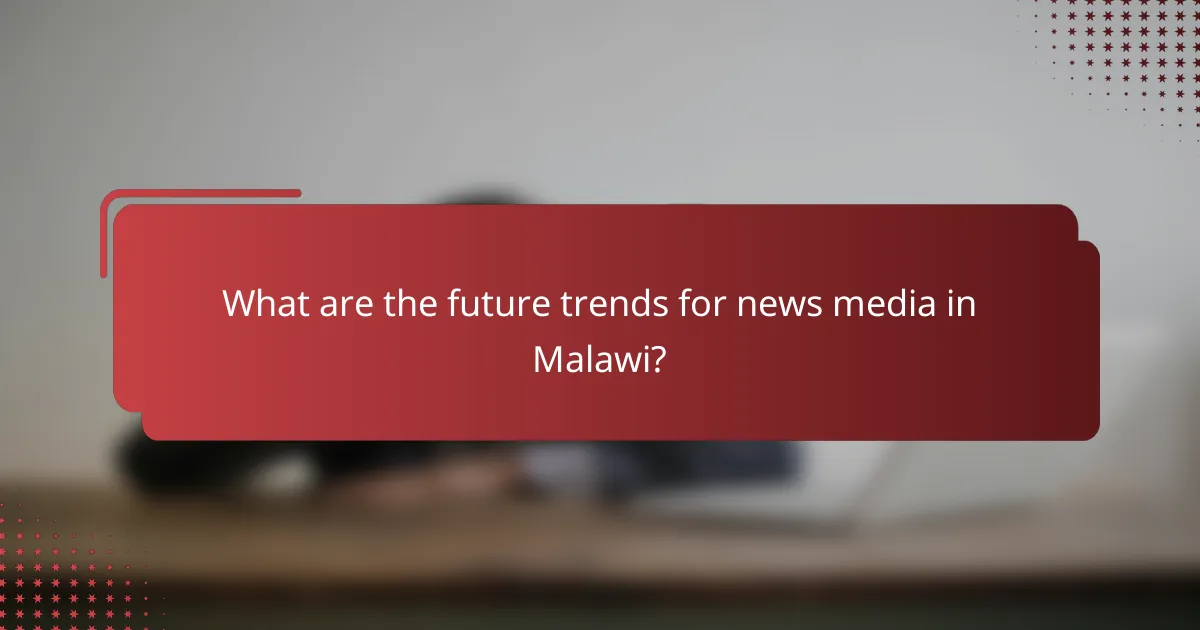
What are the future trends for news media in Malawi?
Future trends for news media in Malawi include increased digitalization and mobile news consumption. The rise of smartphones has significantly changed how people access news. More Malawians are using social media platforms for news updates. Traditional media outlets are adapting by enhancing their online presence. There is a growing emphasis on multimedia content, such as videos and podcasts. Additionally, citizen journalism is gaining traction, allowing individuals to report news stories. The government is also expected to implement policies that promote media freedom. These trends reflect a global shift towards more accessible and diverse news sources.
How is the media landscape expected to evolve in the next decade?
The media landscape is expected to evolve significantly in the next decade. Advances in technology will drive this evolution. Digital platforms will become the primary source of news consumption. Traditional media outlets will increasingly adapt to online formats. Social media will play a crucial role in news dissemination. Audiences will demand real-time updates and interactive content. Data journalism will rise, enhancing storytelling with analytics. Artificial intelligence will personalize news feeds for users. The shift towards mobile consumption will continue to grow, influencing content creation. These trends indicate a dynamic transformation in how news is produced and consumed.
What emerging technologies could further transform media in Malawi?
Emerging technologies that could further transform media in Malawi include mobile internet, social media platforms, and digital content creation tools. Mobile internet [censured] in Malawi has increased significantly, reaching over 40% in recent years. This connectivity allows more citizens to access news and information online. Social media platforms like Facebook and WhatsApp facilitate real-time communication and news sharing. These platforms are becoming primary sources of information for many Malawians. Additionally, digital content creation tools empower local journalists and content creators to produce high-quality media. The rise of affordable smartphones also plays a crucial role in this transformation. As technology continues to evolve, it is likely that media consumption habits will shift further, enhancing the overall media landscape in Malawi.
How might changes in government policy affect media operations?
Changes in government policy can significantly impact media operations. Government regulations can dictate media ownership structures. For example, stricter ownership rules may limit foreign investment in local media. This can reduce funding and resources for media outlets. Additionally, policies on freedom of expression can influence editorial independence. Tighter restrictions may lead to self-censorship among journalists. Conversely, supportive policies can foster a more vibrant media landscape. Historical instances, such as the liberalization of Malawi’s media in the early 1990s, illustrate this effect. During that period, relaxed policies led to a surge in private media outlets and diverse viewpoints.
What challenges and opportunities lie ahead for Malawi news media?
Malawi news media faces significant challenges and opportunities in the coming years. Challenges include limited financial resources and high levels of media censorship. The media landscape is also affected by political interference, which can hinder journalistic independence. Opportunities lie in the growing access to digital platforms. Increased internet [censured] allows for broader audience engagement. The rise of social media presents avenues for innovative storytelling. Additionally, collaborations with international media organizations can enhance capacity building. These dynamics will shape the future of news media in Malawi.
How can local media adapt to the global digital landscape?
Local media can adapt to the global digital landscape by embracing digital platforms and technologies. This includes developing a strong online presence through websites and social media. Local media should invest in digital journalism training for their staff. They can utilize data analytics to understand audience preferences better. Collaborating with global digital news organizations can enhance content reach. Diversifying revenue streams through subscriptions and online advertising is essential. Engaging local communities through interactive content fosters loyalty and readership. According to a 2021 Pew Research Center report, 86% of Americans get news from digital devices, highlighting the importance of digital adaptation for local media.
What strategies can be employed to ensure media sustainability in Malawi?
Strategies to ensure media sustainability in Malawi include diversifying revenue streams. Media organizations can explore subscription models and digital advertising. Training journalists in multimedia skills enhances content quality and reach. Collaborations with NGOs can provide funding and resources. Engaging local communities fosters trust and audience loyalty. Adopting technology for distribution increases accessibility. Research indicates that media sustainability is linked to financial independence and audience engagement. Implementing these strategies can strengthen the media landscape in Malawi.
What best practices can enhance the effectiveness of news media in Malawi?
Enhancing the effectiveness of news media in Malawi involves adopting best practices that promote accuracy, accessibility, and engagement. First, implementing rigorous fact-checking processes can significantly reduce misinformation. Studies show that accurate reporting builds public trust in media outlets. Second, improving digital literacy among the audience ensures better understanding of news content. Research indicates that higher literacy rates correlate with increased media consumption. Third, fostering partnerships between media organizations and civil society can enhance content relevance. Collaborative initiatives often lead to more diverse perspectives in reporting. Fourth, utilizing social media platforms effectively expands reach and engages younger audiences. Data reveals that social media is a primary news source for many Malawians. Finally, investing in training for journalists on ethical standards and reporting techniques strengthens the overall quality of journalism. A well-trained workforce is crucial for maintaining high reporting standards.
How can media organizations engage more effectively with their audiences?
Media organizations can engage more effectively with their audiences by utilizing interactive platforms. These platforms allow for real-time feedback and dialogue. Social media channels are essential for this engagement. They enable organizations to share content and receive immediate responses. Personalized content also enhances audience connection. Tailoring news to specific interests boosts relevance. Data analytics can track audience preferences. This information helps in crafting targeted content. Collaborating with local communities fosters trust and loyalty. Engaging in community events increases visibility and relatability.
What role does media literacy play in the future of news consumption?
Media literacy is crucial for the future of news consumption. It empowers individuals to critically evaluate news sources. This skill helps differentiate between credible information and misinformation. In an age where digital platforms dominate, media literacy becomes essential. According to a 2020 study by the Pew Research Center, 64% of Americans believe that misinformation is a major problem. Enhanced media literacy can combat this issue by fostering analytical skills. As technology evolves, so do the methods of news dissemination. Understanding these changes will shape informed citizens. Ultimately, media literacy will play a pivotal role in ensuring a well-informed public.
The main entity of this article is Malawi news media, which has undergone significant transformations influenced by historical, political, and technological factors. The article examines the evolution of Malawi’s media landscape from its colonial roots, through periods of censorship and the emergence of independent outlets post-independence, to the current state characterized by digital advancements. Key topics include the impact of historical events on media freedom, the role of technology in news consumption, and future trends shaping the media environment in Malawi. Additionally, the discussion highlights challenges faced by local media and strategies for ensuring sustainability and engagement with audiences.

